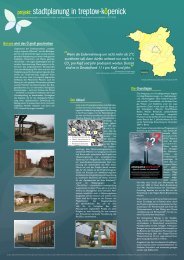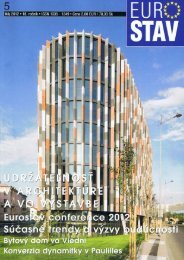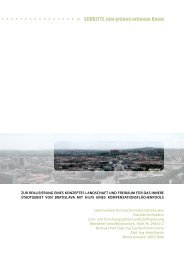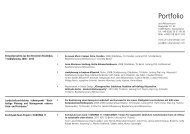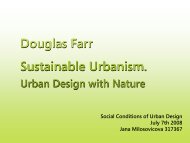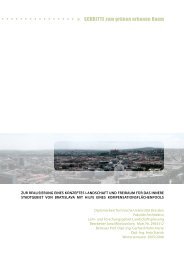Thesis document - Jana Milosovicova - Urban Design English
Thesis document - Jana Milosovicova - Urban Design English
Thesis document - Jana Milosovicova - Urban Design English
- No tags were found...
You also want an ePaper? Increase the reach of your titles
YUMPU automatically turns print PDFs into web optimized ePapers that Google loves.
ought in the section 3.4, are mainly inspired by these guidelines.Fig. 46 NYC’s High Performance InfrastructureGuidelinesThe NYC’s “High Performance Infrastructure Guidelines” (2005)have a broader area of interest, focusing on public open space (e.g.albedo rising on streets, cycle ways and sidewalks). Besides being verythorough and covering a high range of climate-related urban design issues(pavement, stormwater management, landscaping), they do alsobring quantitative statements and recommendations. The quantificationrefers to particular planning aims and objectives, like e.g. statingperformance goals: “Achieve an albedo of 0.3 or higher on road resurfacingand reconstruction projects (p. 82)” or “Seek to capture, retain,treat, and facilitate either infiltration or evapotranspiration of all smallstorms, or 90% of average annual storm runoff volume (p. 125).” Dueto the quantifying character, these guidelines are an inspirative sourcefor determining the extent of measures applied in urban design.Berlin’s <strong>document</strong>s addressing CSUDFor reviewing the recommendations by the city where this <strong>Thesis</strong>’ casestudy area, Heidestrasse/Europacity, is situated, closer attention ispaid to the urban design and planning regulations introduced by theCity of Berlin. The investigation showed that Berlin’s regulations havevaluable provisions for addressing the UHI effect as a general policy toadapt to climate change:• Guidelines “Konzepte der Regenwasserbewirtschaftung”(“Rainwater management Concepts. Greening buildings,cooling buildings” Guidelines, 2010) – Thoroughly discussing theenergy flows and water issues and their relevance in urban design;Aiming at decentralized rainwater management, greening of buildingsand building cooling based on non-conventional adiabaticcooling technology, that uses (rain)water. These guidelines, too,are an inspirative source for the design recommendations for theCSUD Heidestrasse/Europacity;• “Planungshinweise Klima” (Planning Advices <strong>Urban</strong> Climate, Map4.11.2 in the Environmental Atlas Berlin – advisory <strong>document</strong>helping boroughs decide about permissibility of developmentproposals)• “Stadtentwicklungsplan Klima” (City Development Plan Climate) –yet unpublished, city-wide planning <strong>document</strong>, aims at the largerscaleplanning (1:100,000 to 1:20,000); particularly at the spatialallocation of the climatic impact and compensation areas and ofventilation channels of the whole-city significance.Fig. 47 Berlin’s Rainwater Management ConceptsGuidelines.• Remarkably, the planning law, e.g. the “Klimaschutzgesetz –Entwurf” (Climate Protection Law – Draft), despite the knowledgeand awareness at the city’s planning level, only aims at the carbonproblematic and introduction of renewable energies and fully avoidsthe physical impacts of land use and of construction materials andthe urban form.According to the talks with consulted professionals 33 , the principal climate-relatedpriorities in Berlin’s urban development are (a) Land use33 Mr. Andre Heinzel (SenStadt Berlin), Mr. Heinz Brandl (SenStadt Berlin)38Climate Sensitive <strong>Urban</strong> <strong>Design</strong> in Moderate Climate Zone: Responding to Future Heat Waves. Case Study Berlin Heidestrasse/Europacity



